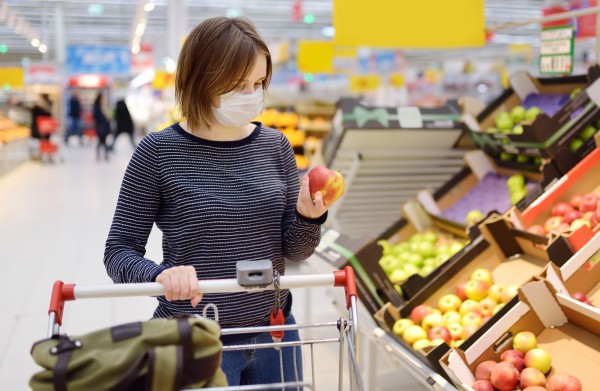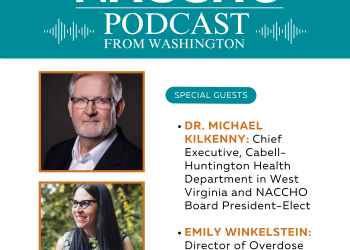Local health departments (LHDs) work each day to ensure the safety of the food we eat.79% and 77%1 of local health departments operate regulation, inspection, and licensing of food service establishments and providing food safety education,2 respectively. LHDs inspect food establishments and investigate citizen complaints and will take action to ensure that a food establishment complies with sanitation standards. Additionally, LHDs work with state, local, tribal, and national partners as well as the industry to prevent, identify, and respond to outbreaks of food-borne illness. Despite retail food establishments being deemed as an essential business during the COVID-19 pandemic, many localities have greatly reduced or ceased their food safety program operations.
Local, state, territorial, and tribal health departments are working to keep food safe for communities during a time when progress in controlling major foodborne pathogens has stalled. In a 2020 report, CDC reported that infections from major pathogens caused by Listeria, Salmonella and Shigella were unchanged and other pathogen infections increased.3 While increased infections may be partially attributed to improvement of laboratory testing practices and more widespread testing, people may also be exposed to more pathogens through food consumption. Foodborne illness is a major preventable public health challenge that causes an estimate of nearly 48 million foodborne disease illnesses each year, with 128,000 requiring hospitalization, and resulting in 3,000 deaths in the United States.4 The CDC states that “reducing foodborne illness will require more widespread implementation of known prevention measures”, which requires health departments to increase their food safety program activities.
Due to limited and decreased funding for public health, local health departments already face capacity and staffing restraints that affect the provision of essential public health services.5 For example, from 2008-2016, local health departments experienced a decline of more than 2,000 environmental health full-time equivalents. These staffing and resource restraints have a great impact in the quantity and quality of services provided. However, the COVID-19 response has exacerbated this deficiency.
Food safety programs that responded to our COVID-19 assessment noted that they have been experiencing varying levels of impact from COVID-19 to their routine operations, ranging from minimal impact to entire food safety programs being shut down, or large portions of staff being reassigned to COVID-19 response. As communities and businesses reopen, the impacts of these reductions in work may have significant impacts.
Additional impacts include:
- Reduced or suspended routine retail food establishment inspections, often because staff are pulled away to focus on COVID-19 response, implementation of social distancing guidelines, or lack of personal protective equipment available to staff.
- Cancellation of food safety classes and training for the food service workers due to implementing social distancing guidelines and lack of staff.
- Delay in recruiting additional staff for open positions.
Despite the workforce and resource challenges, these programs are finding ways to adapt and fulfill their critical public health function while still maintaining social distancing. These include:
- Conducting virtual inspections instead of on-site inspections for complaint investigations and pre-reopening of facilities.
- Engaging and assisting restaurant operators to do more active managerial control to empower them to manage their own food safety.
- Providing guidance on food safety operations through the phone or virtually.
- For programs that ceased routine inspections, staff that have not been re-assigned to COVID-19 are improving their food safety program by working to conform to the FDA Voluntary National Retail Food Regulatory Program Standards.
NACCHO has compiled a list of resources from its partners and members to assist food safety programs in navigating this challenging time. These resources are highlighted below.
- Food and Drug Administration – Best Practices for Re-Opening Retail Food Establishments During the COVID-19 Pandemic Checklist: This checklist addresses key food safety practices for retail food establishments to consider when re-opening and restarting operations.
- Food and Drug Administration – Food Safety and the Coronavirus Disease 2019 (COVID-19) Questions & Answers for Industry: Resources available to industry members and consumers on Coronavirus Disease 2019 (COVID-19) and food safety.
- Food and Drug Administration – Best Practices for Retail Food Stores, Restaurants, and Food Pick-Up/Delivery Services During the COVID-19 Pandemic: Best practices to operate retail food stores, restaurants, and associated pick-up and delivery services during the COVID-19 pandemic to safeguard workers and consumers.
- Ohio Department of Health – COVID-19: Requirements to reopen restaurants and bars: Ohio Department of Health’s recommended best practices and requirements for restaurants and bars to protect against COVID-19 and for re-opening.
- NC State Extension – COVID-19 Food Safety Resources: Best practices for preparing for COVID-19 and managing risk for individuals at home and for food environments such as restaurants, grocery stores, food banks, gardens and farms.
- Centers for Disease Control and Prevention – Communities, Schools, Workplaces, and Events: COVID-19 Guidance for Where You Live, Work, Learn, Pray, and Play.
If you have any questions about these resource or would like to submit a resource of your own to the Food Safety Toolkit, please contact the NACCHO Food Safety Program at [email protected].
More resources on food safety can be found by searching the Food Safety Toolkit in the NACCHO Toolbox. The NACCHO Toolbox is a free, online collection of public health tools that have been created and shared by members of the public health community. To view the Food Safety Toolkit, visit the NACCHO Toolbox and select “Food Safety Toolkit” from the dropdown menu.
For more details on NACCHO’s response to COVID-19, see its COVID-19 information page. If you would like to share how the COVID-19 response is affecting your food safety program, please submit your stories on this short form: https://www.naccho.org/programs/coronavirus. This feedback is critical to our work to advocate on your behalf. Thank you.
References
1 https://www.cdc.gov/mmwr/volumes/69/wr/mm6917a1.htm?s_cid=mm6917a1_w
2 Centers for Disease Control and Prevention. Burden of Foodborne Illness: Findings webpage. Retrieved April 25, 2020, from https://bit.ly/3bVl6JE
3 Trust for America’s Health. (2018). A Funding Crisis for Public Health and Safety: State-by-State Public Health Funding and Key Health Facts. Retrieved May 3, 2020, from https://www.tfah.org/wp-content/uploads/2019/03/InvestInAmericaRpt-FINAL.pdf
4 NACCHO. (2016). National Profile of Local Health Departments. Retrieved May 3, 2020, from https://bit.ly/35s0PJb
5 NACCHO. (2016). National Profile of Local Health Departments. Retrieved May 3, 2020, from https://bit.ly/35s0PJb



